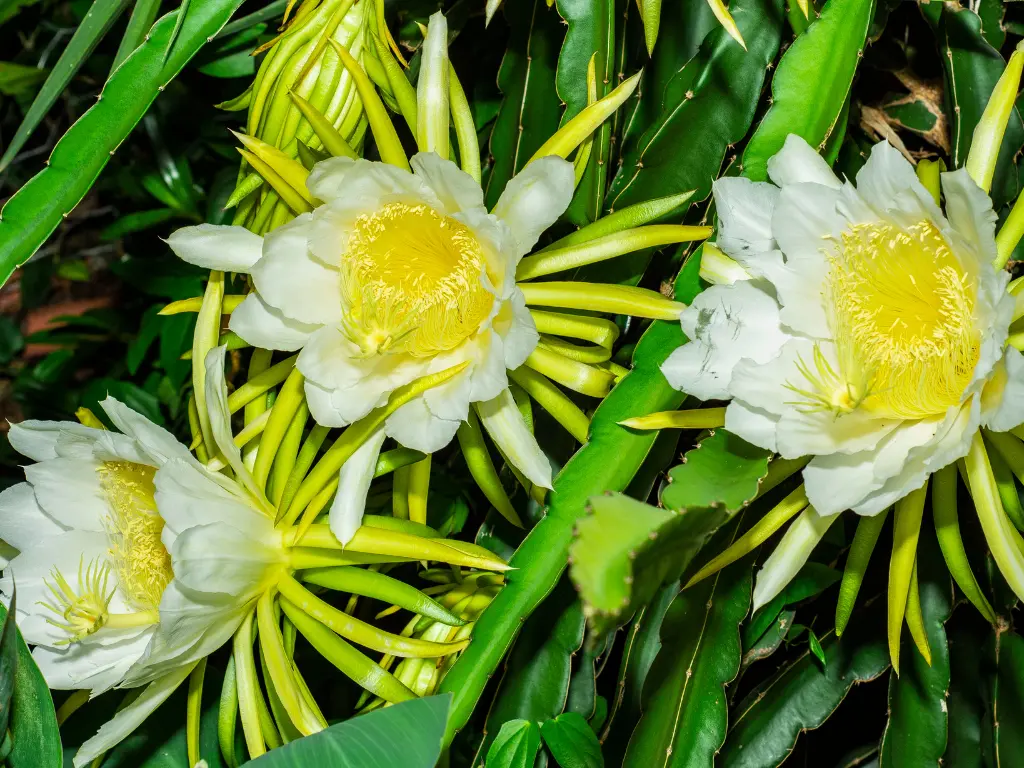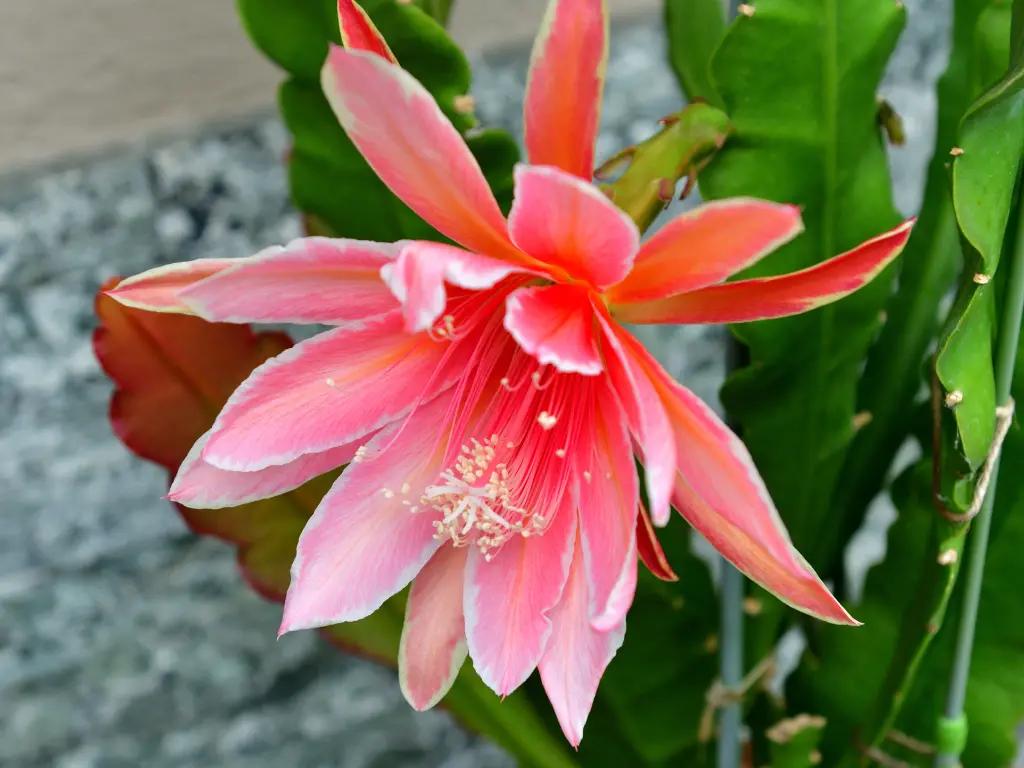Guides
Discover 7 Stunning Types of Night-Blooming Cereus
Have you ever waited for a flower that only opens at night and then disappears by sunrise? If you’ve ever heard about the night-blooming cereus, you already know the magic. But maybe you’re wondering: what are the different types of night-blooming cereus? Which ones are best for beginners? And how do you tell them apart?
I’ve grown these mysterious night bloomers for years, and in this guide, I’ll walk you through the most popular types of night-blooming cereus, their unique traits, and how to grow them successfully—whether you’re gardening indoors or outdoors in the U.S.
You may like:
- Queen of the Night Cactus Care: Secrets to Blooming Success!
- How to Grow Queen of the Night from Cuttings: Easy Step-by-Step Guide
- When and How Queen of the Night Cactus Blooms: A Night You’ll Never Forget
What Is a Night-Blooming Cereus?
Night-blooming cereus, it’s actually a nickname for several cactus species that share one unforgettable habit—they bloom at night.
Most of them belong to genera such as Epiphyllum, Selenicereus, Hylocereus, Peniocereus, and Cereus. These plants open huge, fragrant white flowers that last only a few hours, often releasing a sweet scent to attract nighttime pollinators like moths and bats.
People sometimes call them Queen of the Night cactus, Dutchman’s Pipe cactus, or Orchid cactus. No matter the name, they all share the same spellbinding charm.
There’s something deeply emotional about waiting up for a flower that lives only a few hours.
I remember my first Epiphyllum oxypetalum bloom—it opened around 10 PM, glowing like moonlight. By sunrise, it had wilted completely.
If you’ve ever seen one bloom, you understand the obsession.
-
The flowers are enormous, sometimes 8 to 12 inches wide.
-
They smell like a mix of vanilla and gardenia.
-
They bloom only once or twice a year, usually during summer nights.
That rarity makes each bloom feel like a little miracle. Many collectors even host midnight “bloom parties,” inviting friends to witness the short-lived spectacle.
How to Classify Night Blooming Cereus Types
There are over a dozen species commonly referred to as night-blooming cereus, but most fall into a few key genera:
- Epiphyllum – The Orchid Cactus: These are the most common indoor types. Epiphyllums grow as hanging, flat-stemmed plants that love bright, indirect light.
- Selenicereus – The True Night-Blooming Cereus: This genus includes the famous Selenicereus grandiflorus, often called Queen of the Night.
- Hylocereus – The Dragon Fruit Cactus: Known for producing edible fruit, Hylocereus undatus has become wildly popular for both its blooms and its delicious dragon fruit.
- Peniocereus – The Desert Night Bloomers: Native to the U.S. Southwest, these types look like scraggly sticks most of the year—until one magical summer night when they burst into giant, white blossoms.
- Cereus – The Columnar Giants: These grow tall and upright, with flowers that bloom at night and sometimes produce edible fruits.
The 7 Most Beautiful Types of Night Blooming Cereus
1. Epiphyllum oxypetalum (Queen of the Night)

Probably the most famous of all, this species is what most people mean when they say night-blooming cereus.
-
Origin: Central and South America
-
Appearance: Flat, leaflike stems and large, pure white blooms that open after sunset and wilt by dawn
-
Bloom time: Once or twice a year, usually in summer
-
Light: Bright, indirect sunlight
-
Why people love it: It’s easy to grow indoors, and the blooms are breathtakingly fragrant.
This species is sometimes confused with Selenicereus grandiflorus, but Epiphyllum oxypetalum is far more common in home collections.
Pro tip: Stressing the plant slightly (by keeping it root-bound) can trigger more blooms.
2. Hylocereus undatus (Dragon Fruit or Red Pitaya)

This one might surprise you—it’s both a night-blooming cereus and a fruiting cactus.
-
Origin: Mexico and Central America
-
Appearance: Three-sided green stems that climb or sprawl; large white flowers that open at night
-
Bloom time: Multiple times in summer
-
Bonus: Produces bright pink dragon fruit after flowering
-
Light: Full sun for best results
If you want both beauty and function, this is your type. In the U.S., it grows best in USDA zones 10–11 but can be kept indoors in containers elsewhere.
3. Selenicereus grandiflorus (True Night Blooming Cereus)

This is the original “Queen of the Night.”
-
Origin: Caribbean and Central America
-
Appearance: Thin, vining stems with massive, fragrant blooms (up to 12 inches wide)
-
Bloom time: Usually once per year
-
Light: Bright, indirect light
-
Fun fact: The flowers were once used in herbal medicine for heart tonics.
Because it blooms so rarely, catching it in action feels like a reward for patient care.
4. Peniocereus greggii (Arizona Queen of the Night)
Native to Arizona, New Mexico, and northern Mexico, this desert cereus is famous in the American Southwest.
-
Appearance: Thin, twiglike stems that blend into the desert environment
-
Bloom time: Just one or two nights a year, typically in June or July
-
Habitat: Deserts, rocky areas
-
Special event: In Tucson, Arizona, locals even host “Queen of the Night” festivals to celebrate its bloom.
It’s a wonderful choice if you love native plants and want to witness something rare and wild.
5. Cereus peruvianus (Peruvian Apple Cactus)

-
Appearance: Tall, columnar cactus with ribbed stems and large night-blooming flowers
-
Bonus: Produces small, edible fruit called Peruvian apples
-
Light: Full sun
-
Bloom time: Summer nights, multiple times per year in warm climates
These can grow quite large—up to 30 feet outdoors in warm regions—so they’re best for those with space or outdoor gardens in southern states.
6. Epiphyllum hybrids (Orchid Cactus Mixes)

Hybrid Epiphyllums are perfect for indoor gardeners who want variety.
-
Colors: White, pink, red, or even yellow blooms
-
Bloom time: Varies by hybrid, usually multiple nights during late spring and summer
-
Care: Similar to Epiphyllum oxypetalum—bright light, good drainage, moderate watering
These hybrids have been bred for their stunning flowers and compact size, ideal for hanging baskets or apartment gardens.
7. Selenicereus anthonyanus (Fishbone or Ric Rac Cactus)
Although it’s more known for its zigzag stems, it also produces night-blooming white or pale pink flowers.
-
Appearance: Unique, flat, fishbone-like stems
-
Light: Medium to bright indirect
-
Bloom time: Spring to early summer
-
Why it’s loved: Its funky shape makes it a decorative plant even when it’s not in bloom.
It’s one of the easiest types for beginners and thrives indoors across most U.S. climates.
Choosing the Right Type for Your Space
When picking your cereus, think about:
-
Space: Columnar species like Cereus peruvianus need more room. Hanging types like Epiphyllum are better for small spaces.
-
Bloom frequency: Some bloom once a year (Selenicereus grandiflorus), others bloom multiple times (Hylocereus undatus).
-
Fruit or no fruit: Want edible rewards? Go for Hylocereus or Cereus.
-
Climate: Desert types like Peniocereus greggii prefer dry, hot conditions. Epiphyllum loves humidity.
-
Light conditions: If you’re indoors, choose species that tolerate filtered light.
Here’s a quick guide:
|
Goal |
Best Type |
Notes |
|---|---|---|
|
Beginner indoor gardener |
Epiphyllum oxypetalum |
Easy care, fragrant blooms |
|
Outdoor warm-climate grower |
Hylocereus undatus |
Edible fruit and flowers |
|
Native plant lover |
Peniocereus greggii |
Rare, native to U.S. deserts |
|
Compact decorative plant |
Selenicereus anthonyanus |
Great indoor accent |
Frequently Asked Questions (FAQs)
1. How many nights will a night-blooming cereus bloom each year?
Most bloom just once or twice a year, but species like Hylocereus undatus can bloom multiple times in summer. Each flower lasts only one night.
2. Can I grow a night-blooming cereus indoors in the U.S.?
Absolutely. Epiphyllum species are perfect for indoor environments as long as they get bright, indirect light and good drainage.
3. Which types of night-blooming cereus produce edible fruit?
Hylocereus undatus (dragon fruit) and Cereus peruvianus both produce edible fruit. Others, like Epiphyllum oxypetalum, are purely ornamental.
4. Why is my night-blooming cereus not flowering?
It may need more light, a rest period in winter, or a more mature root system. Avoid repotting too often—blooms come when plants are slightly pot-bound.
Conclusion
If you’ve been curious about the different types of night-blooming cereus, now you know they’re not one plant but a fascinating family of nocturnal bloomers.
Whether you choose the dramatic Queen of the Night, the fruity Hylocereus, or the native Peniocereus, each one rewards patience with a rare, dazzling show.
So pick your favorite type, give it time, and one warm summer night, you’ll wake up to that incredible sight—the moonlight touching a flower that waited all year to meet you.


7 Vegetables to Plant in December for a Bountiful Winter Harvest
Winter gardening is a challenge many new gardeners shy away from. But if you’re among [...]
Dec
9 Common Christmas Cactus Problems and How to Fix Them
Have you ever walked past your Christmas cactus and wondered why it suddenly looks sad? [...]
Nov
Swedish Ivy Care: How to Grow a Healthy, Thriving Plant
Have you ever looked at your Swedish Ivy and wondered why the leaves are turning [...]
Nov
Avoid These 10 Garlic Planting Mistakes for Bigger, Healthier Bulbs
Growing garlic at home is one of the most satisfying things a gardener can do [...]
Nov
How to Prevent Christmas Cactus Bud Drop: Tips for a Healthy Bloom
Have you ever noticed your beautiful Christmas cactus (Schlumbergera) starting to lose its buds just [...]
Nov
Discover 7 Stunning Types of Night-Blooming Cereus
Have you ever waited for a flower that only opens at night and then disappears [...]
Nov